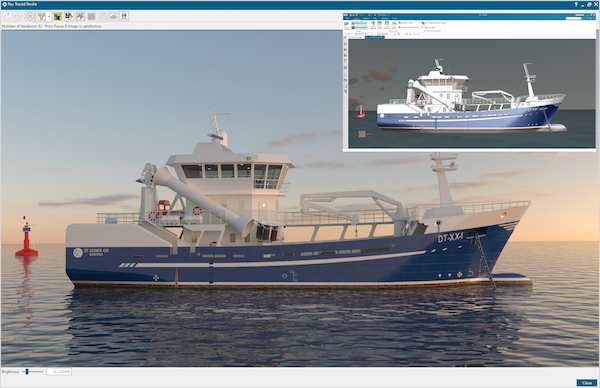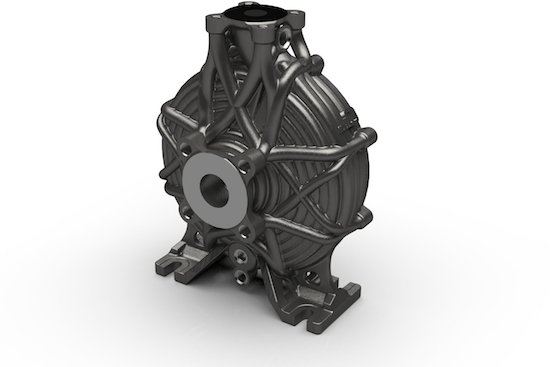
Iray is a push-button renderer that targets simulation and photorealism in product design and AEC environments. Image courtesy of Digitread AS
Latest News
August 7, 2020
The ability to rapidly render and visualize a design has become an increasingly important part of the design process in order to enable product reviews, enhance collaboration, and to provide photorealistic images for marketing, advertising, and other functions.
“Visualization in engineering and in CAD is being driven in large part by the advancements in technology and in entertainment,” says Patti Longwinter, strategic alliances manager at NVIDIA. “We are really seeing that expectation for realistic rendering because they’ve seen it in gaming. And we are not only seeing in traditional applications, like aesthetics for design, but also in manufacturing use cases and even for things like assembly instructions.”
In the past, photorealistic rendering was the realm of specialists, but thanks to technologies like NVIDIA Iray physically based rendering technology, these capabilities are now at the fingertips of every designer with the right workstation.
Iray is a push-button renderer that targets simulation and photorealism in product design and AEC environments. It’s an easy to use solution for professionals who are not rendering experts, but still need to generate convincing imagery. It has been incorporated into a number of leading CAD tools, including Siemens NX.
“Before you needed an expert to transfer everything into a rendering system, and you needed an artist to set up materials and the lighting,” says Alex Fuchs, senior product manager, software, at NVIDIA. “We have tried to give all of these tools to a designer and deliver a push-button solution to the masses that creates the model, and handles the lights, the materials, and the camera. That’s all you need for a great image. With these renderers you can create images that you can use right away in a catalog. Designers have the tools to really tell a great story and explain the product visually.”
In the case of NX, Iray supports visualization across the product lifecycle. The features are fully integrated, and don't require exporting data to a separate rendering application. Longwinter, who previously served as a product manager for NX at Siemens, says that the Iray feature set provides all of the functionality needed for professional rendering.
“Iray supports separate buffers and lightpath expressions, camera effects like motion blur or rounded corners,” she says. “You have a full depth of field, all in stereo and supporting a panoramic lens.”
NVIDIA’s software partners can hide or expose as many features of the solution as they feel necessary for their end user audience.
By providing push-button rendering to designers, Iray not only enables the creation of images for design reviews and marketing but can also provide a way to fully visualize designs without the need to create additional physical prototypes. In industries like aerospace or marine design, that visualization capability can be invaluable. In the current climate, when more designers and customers are working remotely or from home, the ability to quickly create and share these visuals is even more important than ever.
“It’s all about communication,” Fuchs says. “You can demonstrate, illustrate or visualize your design concept in a much more professional way, and you can save money by not sending everything through an agency. You shouldn’t have to wait for hours for a rendering. You should be able to have that immediately.”
To leverage this type of capability, end users still need the right hardware, and that means a professional workstation with an NVIDIA RTX graphics card. According to Fuchs, for most engineers and designers, an NVIDIA® Quadro RTXTM 4000 or NVIDIA Quadro RTXTM 5000 inside a desktop or mobile workstation will do the trick and produce renders in a reasonable amount of time.
Doubling the number of GPUs can cut rendering times in half—users with more advanced requirements could leverage multiple GPUs with NVIDIA NVLink technology or move up in class to the NVIDIA Quadro RTXTM 6000 or NVIDIA QuadroTM RTX 8000, which offers 48GB of GPU memory. (For users that may need occasional access to greater GPU resources, Iray Server provides access to distributed rendering across networked machines.)

KSB, which provides pumps, valves and systems in energy and industrial applications, is leveraging the built-in rendering capabilities of Siemens NX across several applications. Image courtesy of KSB.
Real World Examples
KSB, which provides pumps, valves and systems in energy and industrial applications, is leveraging the built-in rendering capabilities of Siemens NX across several applications. Originally the company used simple screen captures for internal communication and customer presentations.
Once introduced to Iray-based rendering, they have since incorporated it into internal communications, design reviews, sales materials, product manuals and customer-facing presentations.
Digitread, a Siemens reseller offering services and expertise specializing in the marine industry, relies heavily on NX/Iray rendering because marine designs (like yachts) cannot be physically prototyped, and using a standalone renderer can break the digital thread. Using Iray in a managed PLM environment enables the company to create design visualizations more quickly and improve their customer engagements.
(You can learn more about NX and Iray in this recent presentation.)
These applications leverage Iray’s full universe of tools. For example, NX users have access to the vMaterial library, which provides realistic design-oriented materials that can be used right out of the box. Iray also provides fast raytracing, denoising, and Iray Server functionality.
In all cases, designers now have intuitive, rapid rendering right at their fingertips. “The time it would take to produce a final rendered image has been cut down to minutes,” Longwinter says.
More Dell Coverage

More NVIDIA Coverage
Subscribe to our FREE magazine, FREE email newsletters or both!
Latest News







